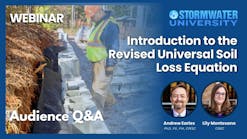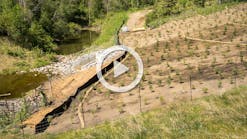About the author: Richard A. McLaughlin and Joshua L. Heitman are professors at North Carolina State University in the Department of Crop and Soil Sciences and are IECA members. McLaughlin can be reached at [email protected]. Heitman can be reached at [email protected].
Richard A. McLaughlin & Joshua L. Heitman
undefinedThe process of constructing roads, buildings and other structures usually requires land disturbance from grading activities. Removing the topsoil and changing the topography to suit development can lead to compacted subsoils at the surface. This in turn creates problems in establishing vegetation and can result in excessive runoff, similar to that in impervious areas.
Surveys have shown that the infiltration rates of recently graded soils can be so low as to be indistinguishable from parking lots. We have been researching methods to improve the properties of these compacted subsoils and measuring the effect on infiltration rates over several years.
To Till or Not to Till?
The first study was a simple design to determine how effective tillage was at improving grass growth and infiltration over the course of a growing season. A fill soil was compacted with multiple truck passes, then plots either were core aerated or tilled with some plots left compacted.
Runoff from the tilled plots in the first growing season was minimal compared with the aerated and compacted plots, both from natural events and simulated rain events. Grass growth also was much better in the tilled plots, with greater root growth at depth. The core aerator only was able to penetrate the compacted soil less than 1 in., and runoff was higher in those plots compared to the untreated, compacted plots. The results suggested that the high infiltration rate obtained through tillage could be maintained if vigorous vegetative cover is established.
Going Organic
Organic matter in mineral soils provides a number of important functions in improving physical and chemical properties for plant growth. Because most subsoils have very little organic matter, a common recommendation is to till in compost to correct this problem. The benefits of compost amendment for long-term soil infiltration improvements have not been well established, so our next project investigated this question.
We created compacted subsoils at three research stations around North Carolina; we then tested the effects of tillage at two depths on infiltration over several years, with and without compost. In this study, we compacted the subsoils using a vibratory roller, and we found that tractor-driven rotary tillers could not penetrate the soil. We completed a preliminary excavation using a backhoe followed by the tillage. Some locations included tillage to different depths (5 to 6 in. or 10 to 12 in.), while others had amendments, such as compost, gypsum and hydrogel granules (cross-linked polyacrylamide). We measured infiltration periodically over a period of two or more years at each site.
Overall, we found that tillage increased infiltration tremendously, and this was maintained throughout the monitoring period. Infiltration rates of 10 to 15 in. per hour or more commonly were attained in the tilled plots. Surprisingly, the compost amendment did not improve infiltration in three of the four trials where it was included. Neither gypsum nor hydrogel granules provided any benefits. We also tested the effect of mower traffic on infiltration and found that this can recompact soil, especially if done under wet conditions, but not in all cases. Compost may provide some buffering of the traffic effects.
These studies have demonstrated that tillage can greatly improve soil infiltration in soils compacted by construction activities, and this effect can be retained if vigorous vegetation is established. It should be noted that these results apply only to areas with minimal traffic, either from pedestrians or heavy equipment. We are currently investigating the potential benefits of substituting pollinator-friendly wildflowers in place of grass for storm water reduction and to create an aesthetically pleasing pollinator habitat.






